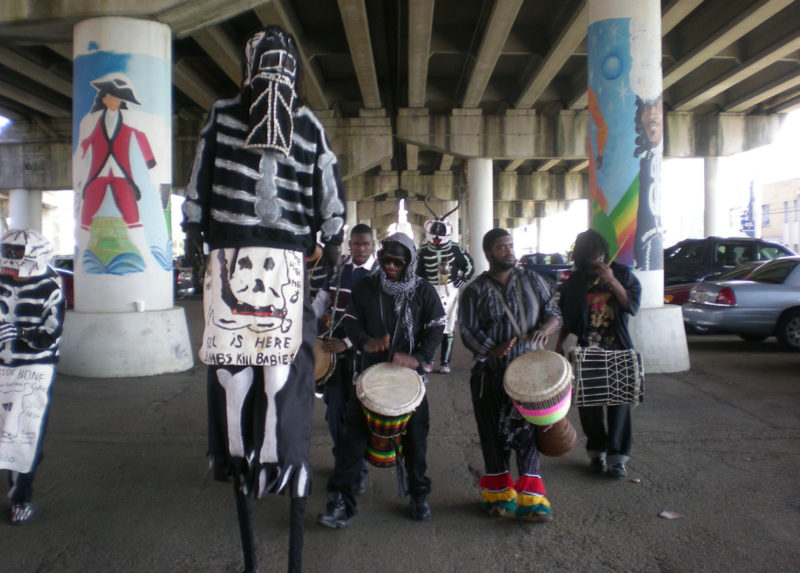
Zohar Israel masking on stilts with drummers from the Northside Skull and Bone Gang. Photograph by Rick Hinterthuer.
Niya: So from what you were saying about the change in Tremé that you had seen – how long would you estimate it took for that change to happen? Was it out of nowhere or was it like gradual?
Zohar: Today it’s called gentrification, they got all kinda terms that they use. But what it boils down to…the landlords would allow the buildings to become dilapidated and run-down, but the whole idea behind that was to bring down the property value. Once they bring down the property value, they would buy up the property cheap, and they would renovate the property, bring it back up, and it become very expensive, and the property value comes back up.
But the people that lived there, most of them was working class people. They had some professionals too, doing some good things for themselves. But as time went on, they were forced out with high insurance, high property taxes would go up. Me myself, my taxes went up within four years from 800 dollars a year, now to 2,300 dollars a year. So the things that they do to people with fixed incomes, you know they couldn’t adjust to it. So they had to leave and go to different places to find housing that they could afford.
Niya: But you still continue to base it in Tremé…amidst that for the sake of preserving something there that has always been there, even though everything around you changed.
Zohar: Well Tremé is connected to black culture of New Orleans. The culture is there, embedded in Tremé. That’s why all of these newcomers are there. It was a very independent place. You had the people on North Claiborne, these black businesses. You had tailor shops, shoe repair shops. You had bars and restaurants from Canal Street all the way down to Elysian Fields. But then they came down with the Interstate. They had oak trees lined up, they had neutral ground all nice. They would have picnics and parties and all kind of celebrations would take place there on Claiborne. But when they came through with the I-10, they came through – they cut down the trees and actually destroyed the neighborhood. And it happens in all the major cities where you have flourishing black business. They tear it down and put up the Interstate to destroy, basically.
 NOLAbeings
Multimedia artist Claire Bangser created NOLAbeings as a portrait-based story project that marries...
NOLAbeings
Multimedia artist Claire Bangser created NOLAbeings as a portrait-based story project that marries...
 Data corner: Adobe Suite (create a PDF, social media graphic, presentation, edit a photo and video
Data corner is where you go to work with analytics and top tech skills. It takes on everything from PERL and SQL to Canva and Sprout Social.
Data corner: Adobe Suite (create a PDF, social media graphic, presentation, edit a photo and video
Data corner is where you go to work with analytics and top tech skills. It takes on everything from PERL and SQL to Canva and Sprout Social.
